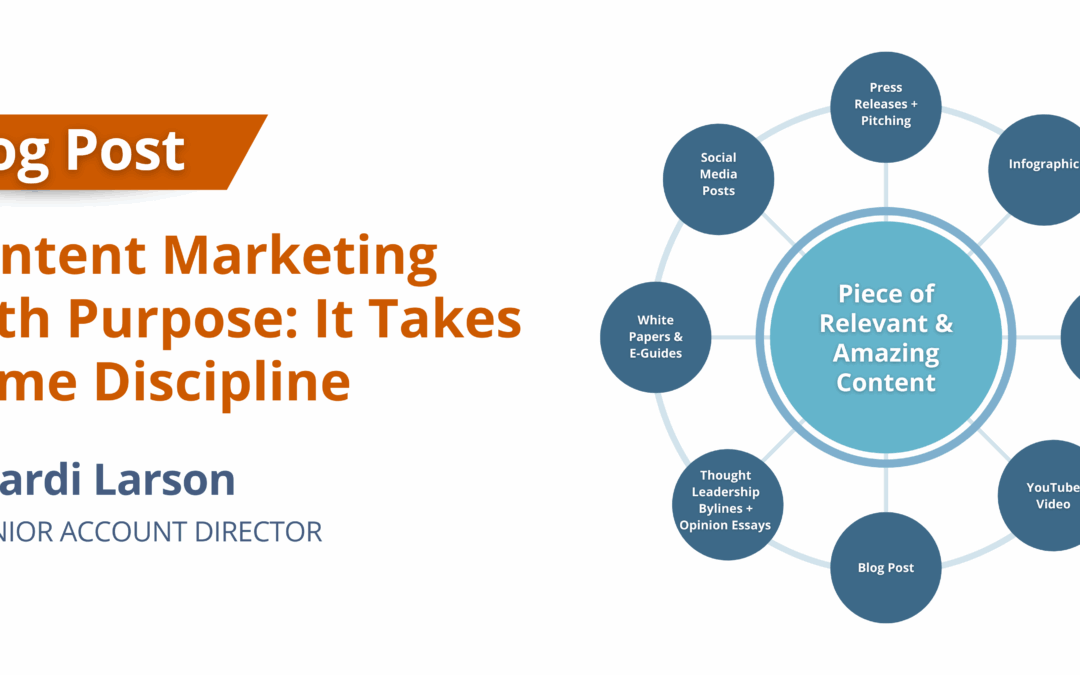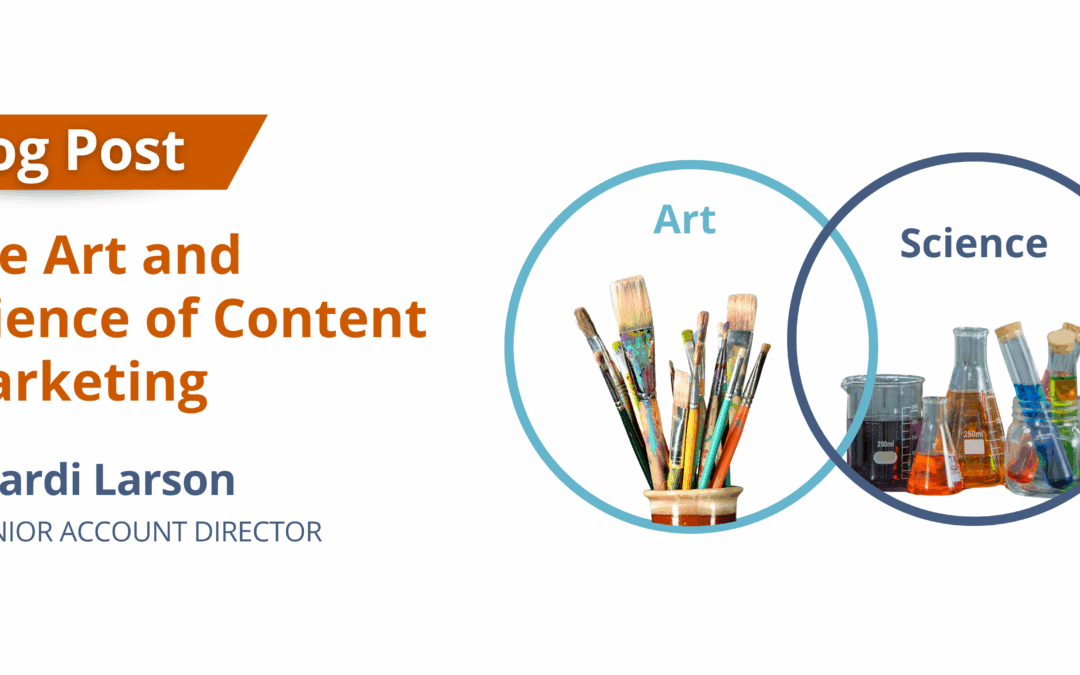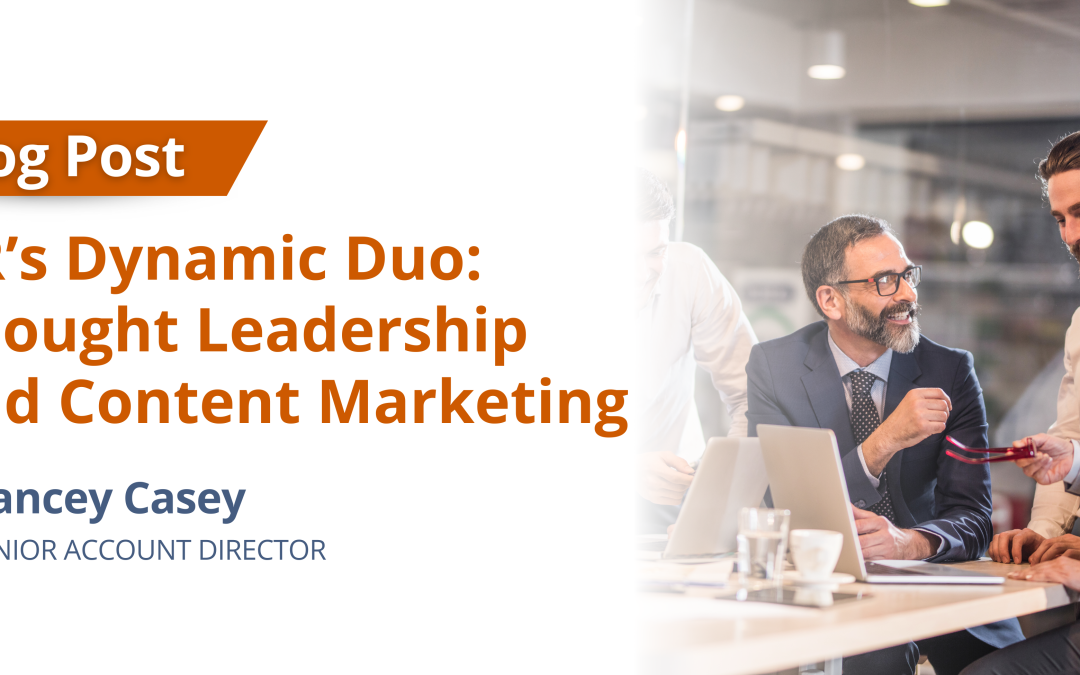
by Mardi Larson | Jul 23, 2025 | Blog
In today’s fast-moving digital world, content marketing takes some discipline. You can’t rely on great content alone — it demands structure, consistency, and a results-driven mindset. To establish true thought leadership and maintain brand credibility over time, organizations must adopt a rigorous approach to content planning, creation, and distribution. Below are some proven best practices that can help advance your overall content marketing program from good to great.
- Develop an Editorial Calendar – Plan your content ahead of time, aligning with product/service launches, company or industry events, webinars, speaking engagements, and more. Don’t forget strategically aligned social holidays, which can help drive engagement.
- Be Helpful and Educate – Drawing from your ideal customer profile and target personas, think through their pain points and what your product or service helps them solve. Think through the questions they ask themselves every day and answer them! Driving out educational and informative content is a great way to position your organization as a thought leader and the go-to resource for smart, useful content.
- Be Relevant – Track the trends and news events in your industry and reference and tie to these regularly. Consider a weekly insights column or quarterly report to curate the top trends to watch with your take on why it matters.
- Create a distribution tip sheet or checklist – Develop a PESO-based content distribution framework specific to your company and refresh it quarterly. I call it this the “Content Marketing Wheel.” Pull it out and review it for each new content opportunity. There are now more channels than ever before from news releases to YouTube and this tool will help you think through the opportunities well suited for each piece of content.
- Monitor and Measure – Use analytics tools to track engagement, media mentions, and conversion rates. Regularly analyze these metrics – some of the best content marketers do this daily! Assess and adjust your content marketing strategy based on channel performance.
- Engage with Industry Influencers – Build relationships with journalists, analysts, and other industry thought leaders to enhance your reach. Foster collaborative opportunities for content co-creation such a joint webinar or co-authored thought leadership article with a business partner — 1+1=3!
- Encourage Employee Advocacy – Empower employees to share content on their professional networks to expand visibility, credibility and optimize content reach. Leverage internal experts and lift them up as brand ambassadors to enhance the credibility of the expert and the organization.
Maximizing Earned Content – Four Key Tips
Earned content — media coverage, awards, analyst reports, and speaking opportunities — is one of the most credible forms of content, but it’s often underleveraged in content marketing and the PESO model. The key to maximizing earned media is following a “create once, share everywhere possible” approach:
- Repurpose Media Coverage – If your company is featured in an article or analyst report, don’t just let it sit on the website of that publication or firm. Share it across your company’s blog, social media channels, and presentation decks. When sharing via blog post, include additional commentary to showcase your expert insights and include a backlink to the article or report. Backlinks to reputable media outlets bolster your website’s authority ranking on search engines like Google.
- Leverage Awards and Recognition – If your company wins an award, create a news release and issue it on a wire service, share the news on social media, update your website, and include it in email campaigns. Consider running a paid campaign sharing this exciting news. Recognition builds credibility, but only if people know about it.
- Maximize Speaking Engagements – When a leader from your company speaks at an event, record it, create short video clips for social media, and repurpose key takeaways into a post or infographic for your company’s blog. Consider turning the presentation content into a LinkedIn article series, a webinar or a podcast episode for additional mileage. Don’t forget to do a news release covering the speaking engagement either before the event or after and be sure to include details and key callouts from the high-value presentation itself.
- Cross-Promote on Different Channels – Content should not exist in silos. Leverage your high-value content everywhere possible. Reinforce thought leadership by integrating earned content across the many channels you have available to you. When you get a piece of high-value earned media coverage, pull out your Content Marketing Wheel to decide where to share it.
Make Every Piece of Content Count
Be disciplined, stay proactive, and always look for ways to get more mileage out of every single piece of content you create.
Great content doesn’t just inform — it influences, builds trust, and opens doors. By applying structure to your content marketing strategy and embracing a disciplined, PESO-aligned approach, you can unlock the full value of every asset you create. Always ask: how can we make this content piece go further?
If you’re looking to bring more rigor and results to your content marketing, the A-Team is here to help. From strategy to execution, we know how to make your content work harder — and smarter — for your brand or business.

by Mardi Larson | Jul 9, 2025 | Blog
Content marketing is a specialized function of marketing that focuses on creating, publishing, and distributing valuable, relevant, and high-value content to attract and engage target audiences. Having been in strategic communications roles for more than three decades, I embrace this model as the modern version of yesteryear’s “integrated communications” approach, where we ensured that content was widely distributed and shared across all the communications channels available to us. Back then there were only a handful of channels where today new channels are popping up every nanosecond, making content marketing programs more opportunistic and increasingly complicated all at the same time.
Content marketing is a smart approach for companies of all sizes, including early stage and maturing companies that want to establish themselves as thought leaders, as well as to build trust, establish industry authority, generate leads, and ultimately drive profitable customer engagements.
Content marketing is both an art and a science.
It requires creativity to craft compelling stories with helpful information that’s search engine optimized, as well as the discipline to ensure that content is planned out and effectively distributed and leveraged across all communications channels for maximum impact. In today’s fast-paced digital media landscape, simply creating great content and posting it on a company blog isn’t enough. You need a disciplined approach to ensure the great content you worked so hard to create reaches audiences across all the ever-evolving channels available.
I have a mantra – create once, publish and post everywhere possible. The art of repurposing content across all the channels is important. Communications pieces shouldn’t be siloed, they should be shared.
That’s where the PESO model comes in.
Understanding the PESO Model
The PESO model stands for Paid, Earned, Shared, and Owned and it is a structured framework for content distribution that ensures your content gains maximum exposure. Let’s break down PESO across the four areas and the common channels and forums within each.
- Paid Media includes traditional and digital advertising where companies pay for visibility. It quickly expands reach, driving targeted website traffic and increasing brand awareness. Common paid media channels include:
- Social media ads (Facebook, LinkedIn, Instagram, TikTok, etc.)
- Pay-per-click (PPC) search engine advertising
- Display advertising (banner ads, retargeting, and programmatic ads)
- Sponsored content and paid influencer partnerships
- Streaming ads on Hulu, NetFlix, Amazon Prime, etc.
- Traditional media such as TV, radio, billboards
- Earned Media is exposure gained through third-party entities. Earned media is just that – earned (not paid for). And it’s one of the most credible forms of media in the PESO model. It comes from external sources that provide the added value of independent validation for your company – its expertise, opinion, innovation or product. Earned media includes:
- Press coverage (features, quotes, and mentions in the media)
- Industry awards and recognitions
- Speaking engagements at conferences and industry events
- Coverage in industry analyst reports and recommendations
- Shared Media involves organic content distribution through social engagement. Shared media is a critical component for consumer brands and is often an underutilized area for B2B companies. This includes:
- Social media shares and engagements
- User-generated content (customers organically sharing experiences with your brand)
- Brand/company mentions and hashtags
- Organic, non-paid influencer engagement
- Community discussions (LinkedIn groups, Reddit, industry forums)
- Owned Media refers to content that a company owns and thus directly controls. These channels are essential because they allow companies to manage their messaging, share stories and provide valuable resources to their audiences. Examples include:
- Blog posts and company website content
- Whitepapers, case studies, e-books, infographics, reports and other informational resources
- Webinars, podcasts, and newsletters
- Sales presentations and corporate reports
- News releases
For a content marketing strategy to be successful, all four PESO areas and the many channels and forums nested within each should be considered.
Don’t just do a webinar – leverage the content across as many channels as possible. Don’t just do a news release on a news wire service, create a blog about bylined directly from an on-staff expert offering a personal perspective, post it to your newsroom and create social media posts. And that high-value earned media coverage, share it everywhere – work it into speaking engagements, awards applications, sales presentations, marketing collateral, social media channels, investor decks and more.
Content marketing isn’t just about creating high-impact and useful content – it involves strategic distribution and integration across multiple communication channels and touchpoints. By following the PESO model and maximizing earned media through smart distribution, companies can enhance their credibility and position themselves as true industry thought leaders. Their companies will come up more easily in online traditional and generative search, which is powerful for any B2B thought leadership brand.

by Janet Mordecai | Apr 16, 2025 | Blog
Healthcare is complicated and constantly evolving. From navigating strict regulations to addressing diverse stakeholders, healthcare sales teams operate in an increasingly competitive and nuanced environment. Fortunately, marketing teams can play an essential role in amplifying and supporting sales efforts and ensuring sales teams have the tool kit required to deliver success. Working hand-in-glove with sales, marketing can help build cohesive and persuasive messaging, comply with regulatory requirements, and support lead generation with strategically crafted content and campaigns designed to capture the attention of target audiences, nurture their interest, and encourage them to take specific actions.
The Healthcare Sales Landscape
It’s no surprise that healthcare sales teams, in particular, face challenges directly related to the diversity of their target audiences, ranging from hospitals to health plan CEOs to clinicians and patients. Each stakeholder has unique priorities and pain points that must be addressed with a tailored solution or call to action. It’s also true that the U.S. healthcare industry is subject to strict regulations, such as HIPAA, which makes compliance a crucial factor in sales and marketing strategies. Marketing teams can help lay a solid foundation that builds trust, and bolsters thought leadership with clients, prospects, and patients.
Generating High-Quality Leads
In my decades of experience in marketing, lead generation is a crucial focus for sales/marketing collaborations – after all, it’s the core of business growth. Leads drive sales opportunities, boost revenue, and increase brand awareness, and it’s one of the main activities in which marketing can support sales objectives. Without compelling and engaging content, sales can’t drive to the bottom of the funnel. That’s where marketing comes in. A healthcare marketing team can create a white paper on the benefits of a new diagnostic tool or host a webinar on improving patient outcomes through innovative technology.
By providing valuable insights and thought leadership, marketing teams capture leads and position their organization as an industry authority. This establishes credibility and trust, making it easier for sales teams to initiate conversations and close deals.
Equipping Sales Teams with Enablement Tools
Marketing’s role, however, doesn’t stop with lead generation – it can and should move into building an integrated strategy and tactics that provide sales teams with the “enablement” tools and resources to convert leads into clients. These resources may include:
- Sales Collateral: Brochures and product guides tailored to the needs of different stakeholders.
- Pitch Decks: Customizable presentations highlighting key product or service benefits.
- Battle Cards: One-page documents comparing your product or service to competitors that help sales address objections and highlight key differentiators.
- Customer Personas: Detailed profiles of target buyers, including pain points, motivations, and preferred communication styles. These guide sales teams in personalizing their outreach.
- Whitepapers or eBooks: High-value content pieces that establish thought leadership and can be shared with leads to nurture trust and demonstrate expertise.
By creating resources that align and support the sales team’s objectives, marketing can help ensure that every interaction with potential clients is meaningful and impactful.
Creating a Cohesive Narrative
Building and implementing consistent messaging is crucial for sales and marketing, serving as a strong foundation for engagement and customer loyalty. This is especially true in today’s healthcare environment, where trust and credibility are paramount to growth and sustainability. Here again, marketing teams can play a vital role in creating a cohesive narrative that aligns with the organization’s mission and values. Marketing can also help weave this cohesive narrative through all communications and channels, from website content to social media posts and email campaigns.
A unified message strengthens the organization’s brand and ensures that sales teams deliver a consistent pitch to clients for a seamless customer experience, increasing the likelihood of success.
Driving Sales Through Digital Engagement
We live in a digital-first landscape, which means marketing should also support healthcare sales teams by leveraging digital channels to engage prospects and clients. Targeted advertising, search engine optimization (SEO), and social media campaigns allow marketing teams to reach potential and existing clients where they are most active and open to engaging. Additionally, digital channels can enable personalized and timely communication, nurturing leads throughout the sales funnel.
For example, a targeted LinkedIn campaign might highlight a new study demonstrating the efficacy of a medical device, driving traffic to a dedicated landing page where prospects can learn more or request a demo. This kind of digital engagement generates leads and keeps them engaged until they’re ready to connect with a sales representative.
Measuring Success and Refining Strategies
Accurately measuring success and adjusting strategies requires continuous collaboration between marketing and sales to meet evolving business objectives and revenue goals. So, it’s best to begin any sales/marketing initiative with an agreement on which key performance indicators (KPIs) will provide valuable insights into what’s working and what isn’t.
Together, marketing and sales can jointly optimize campaigns and improve through open lines of communication and sharing data and strategic insights. This open approach also ensures that organizations remain agile and responsive to changing market dynamics.
Conclusion
The complexity and rapid evolution of the healthcare industry necessitate collaboration between marketing and sales to help drive business and revenue growth and improve client success. Marketing supports lead generation and empowers sales teams with the resources, insights, and narrative consistency they need to succeed. By working together, marketing and sales can navigate the complexities of the healthcare landscape, driving growth and making a meaningful impact on patients and providers.

by Yancey Casey | Nov 13, 2024 | Blog
When these two titans join forces, your brand can’t lose
In the fast-paced world of PR, two heavyweights reign supreme – thought leadership and content marketing. These two strategies are often seen as the Batman and Robin of the marketing world, each with its unique strengths, but unbeatable when working together. If your brand is looking to build awareness, nurture relationships, and drive sales, it’s essential to understand how these two superhero strategies differ and why they should join forces.
The Power of Thought Leadership: Be the Batman of Your Industry
Thought leadership is like Batman – the brooding, strategic hero who relies on intellect and influence. It’s all about positioning your business or executives as the experts in your field. Thought leadership doesn’t push products; it pushes ideas. It starts conversations by offering groundbreaking insights, deep industry knowledge, and forward-thinking solutions to industry-wide challenges.
Think of thought leadership as the superhero who swoops in with a compelling, well-researched article that makes people sit up and say, “I never thought about it that way.” It’s designed to build trust and credibility over time, often appearing in high-profile publications or at industry events. The goal is to create a direct connection with the audience through valuable information, not a sales pitch.
This approach is particularly powerful for companies with complex solutions or those trying to establish themselves as visionary leaders in their market. Like Batman’s utility belt, thought leadership is packed with research, statistics, and innovative ideas that can help a business make an unforgettable first impression.
The Charm of Content Marketing: Robin Leaps into Action
If thought leadership is Batman, content marketing is Robin – the energetic, engaging sidekick who’s quick to jump into action. Content marketing focuses on building relationships with customers through consistent, valuable content like blog posts, social media updates, and newsletters. It’s a top-down communication method, designed to inform and engage the target audience with relevant information that positions the company as the go-to solution for their needs.
While thought leadership is about starting big-picture conversations, content marketing is about nurturing existing relationships. The tone is often less formal and more focused on helping the audience solve specific problems. Whether you’re targeting businesses (B2B) or consumers (B2C), content marketing aims to deliver useful, actionable content that keeps your brand top-of-mind when the time comes for customers to act.
The secret weapon here? Consistency. By regularly producing engaging content, you’re keeping the conversation alive, and that familiarity builds trust. Over time, this tactic turns prospects into customers, and customers into loyal advocates.
The Dynamic Duo: Better Together
While thought leadership and content marketing can each stand alone, they become an unstoppable force when used together. Thought leadership gets you noticed and sparks conversations, while content marketing keeps those conversations going and turns that initial interest into action. It’s like Batman swooping in to save the day, and Robin following up to make sure the job gets done. Let’s break down how these two work together:
- Thought Leadership for Brand Positioning: Thought leadership content, such as expert opinions, research papers, bylined articles, or speeches, positions your brand as a leader in your industry. This content isn’t created to sell directly but to establish authority and trust. It builds credibility with your audience and makes people want to learn more.
- Content Marketing for Engagement: Once you’ve captured attention with thought leadership, content marketing steps in to maintain engagement. This consistent, accessible content keeps your audience informed, addresses their needs, and nurtures them toward a buying decision. Blog posts, case studies, how-to guides, and newsletters all keep the conversation going and provide ongoing value.
- Creating a Funnel: Thought leadership is typically used higher in the sales funnel, where the goal is to create awareness and attract a broad audience. Content marketing, on the other hand, operates lower in the funnel, guiding prospects toward decision-making by offering practical advice and solutions that lead to conversions.
The key is that both strategies ultimately serve the same goal – building relationships and driving sales. Thought leadership opens the door, creating interest and trust, while content marketing nurtures that interest until the audience is ready to commit.
Why You Need Both for PR Success
In today’s competitive market, brands need more than just a one-dimensional approach to marketing. Thought leadership is critical for establishing credibility and making your brand stand out as an industry expert. Meanwhile, content marketing keeps the conversation going, offering consistent value that turns prospects into customers.
When used together, these two marketing superheroes provide a powerful combination that can elevate your brand to new heights. Thought leadership gives you the big-picture, industry-defining ideas, while content marketing keeps your audience engaged on a day-to-day basis. Together, they form the ultimate duo, ready to save the day for your brand’s PR strategy.

by Brandon Glenn | Feb 17, 2021 | Blog
Of all the deliverables we routinely encounter in public relations, none presents as much of a challenge as the humble byline.
Press releases are necessarily to-the-point and formulaic. Blog posts are often quick-and-dirty shorter pieces that are meant to quickly touch on a specific topic, rather than delve in deeply. (White papers don’t qualify as “routine” as they should be employed sparingly; once per quarter, at most, and even that may be pushing it.)
Bylines, however, are altogether different. To craft a coherent, well-reasoned, nonpromotional 800 to 1,000-word article that offers background, explanation and possible solutions on a pressing industry issue is difficult for a writer to do even in his or her own voice. Add to it the PR writer’s challenge of crafting the piece using the client’s thoughts in the client’s voice and the exercise becomes significantly more arduous.
In that spirit, following are three quick tips for writing a better byline.
Develop a written plan before any phone calls: To make the best use of subject matter experts’ (SMEs) time, start planning your byline long before any phone calls. What’s the major theme or “angle” you’re looking to convey to the reader? Start by brainstorming potential headlines, and then after you have a few, write out what could be the first couple sentences of the article. If you’re unable to get this far, it’s a strong sign your plan for the article isn’t solid enough, and it’s time to refine or rethink the angle.
Do your research: It’s fairly rare to find an idea that is completely new. In other words, whatever you’re planning to write about, it’s likely someone else has written about the same, or a similar, topic previously. Do a few variations of Google searches around the topic you’re planning to write about to evaluate what’s been said before. This will provide an idea of the well-trodden ground that’s been discussed ad nauseum and is better avoided, as well potentially spark ideas for new angles. Further, avail yourself of the research that other writers have performed. Good reporters will “show their receipts” in their articles with links to studies, surveys, data and other articles that can provide helpful background. Save time and boost efficiency by taking advantage of the work that’s already been done.
Come up with a targeted list of questions: Also filed under, “Don’t waste SMEs’ time.” Draw up a list of targeted questions for call participants to review prior to the call. In my experience, the top reason byline intake calls go off-the-rails is lack of preparation. Following a list of predetermined questions enables participants to remain focused and helps keep the call running smoothly. If you’re lucky, the SME will even read over the questions prior to the call and ponder potential responses, which generally helps immensely to boost a byline’s quality in the end.
Due to the nature of what we’re trying to accomplish with bylines, they’ll always be challenging to write. But there is a formula for success. Follow the three tips above to craft better bylines.
Page 1 of 1512345...10...»Last »




